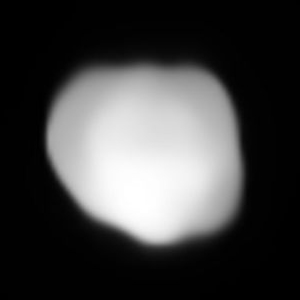(16) psyche
|
Asteroid (16) psyche |
|
|---|---|

|
|
| Image taken by the Very Large Telescope on November 30, 2018 | |
| Properties of the orbit ( animation ) | |
| Orbit type | Main belt asteroid |
| Major semi-axis | 2.926 AU |
| eccentricity | 0.1349 |
| Perihelion - aphelion | 2.531 AU - 3.320 AU |
| Inclination of the orbit plane | 3.10 ° |
| Length of the ascending node | 150.3 ° |
| Argument of the periapsis | 227.5 ° |
| Time of passage of the perihelion | 17th April 2015 |
| Sidereal period | 5 a 2 d |
| Mean orbital velocity | 17.34 km / s |
| Physical Properties | |
| Medium diameter | 226 km |
| Dimensions | 2.72 ± 0.75 x 10 19 kg |
| Albedo | 0.12 |
| Medium density | 4.5 ± 1.4 g / cm³ |
| Rotation period | 4 h 12 min |
| Absolute brightness | 5.9 likes |
|
Spectral class (according to Tholen) |
M. |
|
Spectral class (according to SMASSII) |
X |
| history | |
| Explorer | Annibale De Gasparis |
| Date of discovery | March 17, 1852 |
| Source: Unless otherwise stated, the data comes from JPL Small-Body Database Browser . The affiliation to an asteroid family is automatically determined from the AstDyS-2 database . Please also note the note on asteroid items. | |
(16) Psyche is an asteroid of the main asteroid belt discovered by Annibale De Gasparis on April 17, 1852 . The heavenly body was named after Psyche , the wife of the Greek god Eros .
description
The psyche moves at a distance of 2.5 ( perihelion ) to 3.3 (aphelion) astronomical units around the sun in around 5 years . The orbit is inclined 3.1 ° to the ecliptic , the orbit eccentricity is 0.135.
With a diameter of 250 km, Psyche is one of the largest asteroids in the main belt. It has a relatively light surface with an albedo of 0.12. It rotates once around its own axis in 4 hours and 12 minutes.
Radar observations showed that psyche is made up of iron and nickel. In contrast to other M-class asteroids, no water or material containing water could be detected on the surface. This also indicates a metallic asteroid. More recent measurements with the IRTF have found indications of small amounts of bound water on the surface of Psyche. This is interpreted as a consequence of collisions that could have occurred between Psyche and asteroids of the carbonaceous chondrite type .
If the density is too low to have a predominantly metallic composition, (16) Psyche is a candidate for the origin of the mesosiderites .
NASA mission
Psyche was selected as a target for an unmanned mission of the same name in January 2017 as part of NASA's Discovery program . The planned probe is to start in 2022 and from 2026 to explore the asteroid from an increasingly narrow orbit for at least one and a half years.
See also
Individual evidence
- ↑ a b c Radar observations and shape model of asteroid 16 Psyche echo.jpl.nasa.gov, PDF accessed on November 1, 2017
- ^ SJ Ostro: Radar observations of asteroids and comets . In: Astronomical Society of the Pacific, Publications . tape 97 , 1985, doi : 10.1086 / 131619 , bibcode : 1985PASP ... 97..877O .
- ↑ C. Magri: Mainbelt Asteroids: Results of Arecibo and Goldstone Radar Observations of 37 Objects during 1980-1995 . In: Icarus . tape 140 , no. 2 , 1999, doi : 10.1006 / icar.1999.6130 , bibcode : 1999Icar..140..379M .
- ↑ E. Merényi: Prediction of Water in Asteroids from Spectral Data Short Ward of 3 microns . In: Icarus . tape 129 , no. 2 , 1997, p. 421 , doi : 10.1006 / icar.1997.5796 , bibcode : 1997Icar..129..421M .
- ↑ Tilmann Althaus: Does psyche have water? In: Spectrum of Science. November 2, 2016, accessed January 10, 2017 .
- ^ DR Davis, Paolo Farinella, M. Francesco: The Missing Psyche Family: Collisionally Eroded or Never Formed? . In: Icarus . 137, No. 1, 1999, p. 140. bibcode : 1999Icar..137..140D . doi : 10.1006 / icar.1998.6037 .
- ↑ NASA Selects Two Missions to Explore the Early Solar System. January 4, 2017, accessed January 10, 2017 .
- ^ Arizona State University, Psyche Mission website
